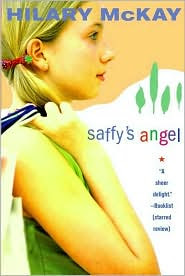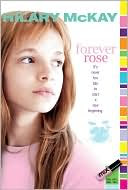Saffy's Angel (Book 1 in the Casson Family Series) by Hilary McKay, 160 pp, RL 4

With Saffy's Angel, Hilary McKay introduces us to the very creative, very eccentric, Casson family who live outside of London. Bill and Eve Casson are both painters. Bill has a studio in London where he lives and paints during the week and Eve has a shed out behind the house where she paints. The Casson children have all been given names from the color chart that hangs prominently in the kitchen of their home. The eldest is Cadmium Gold, or Caddy, then Saffron, Ingido and Permanent Rose. When the story begins, Saffron is eight years old, just becoming a skilled reader, and perusing the color chart. At the same time, Caddy is sitting at the dinner table painting the feet of one of her many hamsters, Indigo is sorting through the coal bin for pieces flecked with gold and Rose, less than a year old, is being inspected by the health worker since her health has been shaky since her birth. As the health worker pries a tube of ochre paint from Rose's little fist, paint she has been sucking on which accounts for her yellowish tinge and necessitates a trip to the emergency room, Saffron notices that her name is not on the chart. She becomes very upset, loudly asking why she isn't on the chart when the worker asks, "Doesn't she know?" as Caddy's hamster makes colorful, delicate footprints all over her paperwork and Indigo stirs up a cloud of coal dust on the hearth.
The opening scene of Saffy's Angel is representative of the level of low-grade chaos, domesticity and creativity that courses throughout the novel. There are so many charming, unique, loving details in this relatively short book that I could go on for pages writing about them. There is the way Indigo considers his sisters his "pack," and places his concern for them above all else. There is the scene in which Caddy encounters Rose, now five or six years old and quickly becoming a skilled artist, painting a picture using only foods as paint. Caddy helpfully suggests the gel toothpaste as a good source of blue. There is the scene in which Saffy, the only one in the family who seems to resent Bill's life in London, is screaming and throwing tomato sandwiches at his taxi as he drives away to the train station, back to his quiet, tidy life, away from the routineless, jumbled existence that is life in the Banana House (so named because of a plaque over the door when they moved in.) There is Eve making her "brain juice," which consists of instant coffee and cola stirred up together, invented when she had to spend all day mothering her children and all night tending to a fretful baby Rose. But, what you come away with at the end of the book is that, no matter what the level of messy existence in the home, the Casson children have a deep and protective love for each other that allows them to overcome their fears and feel at home in the world.
The angel of the title refers to a statue that stood in the garden of the home Saffy shared with her mother, Eve's twin sister, until she was three years old. That was when, during a visit from her grandfather, her mother died in a car crash. He returned to England with a crying three year old and a car full of toys, however, he could not bring the statue, upon which he had written the words, "Saffy's Angel" in blue pencil, with them. After settling Saffy in with the Cassons, he returns to Italy for the statue and, on the way home suffers a stroke that causes him to crash his Bentley and lose his capacity for speech for the rest of his life. When Saffy is thirteen her grandfather dies. In his will he leaves his crumbling house in Wales to Caddy, his wrecked Bentley to Indigo and $300 to Rose, which Caddy gets all in one pound coins that Rose then super glues together, paints gold and turns into a work of art. To Saffy, he leaves her angel. Knowing nothing about the angel, Bill and Eve at first think this is a figurative term. However, Saffy, who is haunted by dreams of a white, stone walled garden, comes to believe that her angel must be a statue from her life in Siena.
With her new found friend, the wheelchair bound Sarah Warbeck, she pursues her angel. And, when she cannot find it on her own, Indigo, Caddy and Rose get in on the game. How they do it is amusing and touching. There are several other plot threads woven into this colorful book that leave you wanting more of the Cassons, which is a good thing since there are four more books about them.

In Indigo's Star, Indigo misses a semester of school when he comes down with glandular fever (mononucleousis.) This isn't too troubling for him since he also gets to miss the school bullies flushing his head down the toilet. When he does return to school, Saffy and Sarah are there to offer protection, but it is his friendship with the American, Tom, that helps him get through the rest of the year. Caddy is off at University in London, Rose is dreading the news that she must wear glasses and Bill and Eve are still both working away in their separate studios miles and miles apart.

In Permanent Rose Caddy is engaged, and not always happily so. Indigo is cautiously beginning a friendship with the reformed bully, David, who yearns to be part of the Casson family. Saffy and Sarah are on a mission to find Saffy's biological father. And Rose has taken up a life of crime while trying to find where her American friend Tom has gone off to.

In Caddy Ever After, rather than the third person narrator Hilary McKay usually employs, alternating chapters are narrated by Caddy, Saffy, Indigo and Rose and all stories revolve around Valentine's Day in one way or another...

The fifth and final Casson, Forever Rose, finds an eleven-year old Rose who is missing her family. Caddy is now twenty-three and nowhere to be found, Saffy is eighteen, Indigo sixteen and Bill and Eve are separated. Rose finds herself mixed up in her best friend's plan to spend the night in the zoo in the arctic foxes' enclosure. As Marie Orlando says in her review for the Suffolk Cooperative Libary System, "What results from a mischeivous, if dangerous escapde are some surprising resolutions to Rose's disenchantment with school and home, and even a new configuration of the family. McKay is at the top of he game with this poignant, hilarious account, narrated in diary form by the irrepressible, artistic, Rose. Readers will empathize with her frustrations, secretly admire her and Kiran's sassiness, and cheer as everything falls nicely, and unexpectedly, into place."
Readers who liked this book might also enjoy:
Saffy's Angel by Hilary McKay
School Story by Andrew Clements
My Last Best Friend by Julie Bowe
Book of Coupons by Susie Morgenstern
Everything on a Waffle by Polly Horvath


